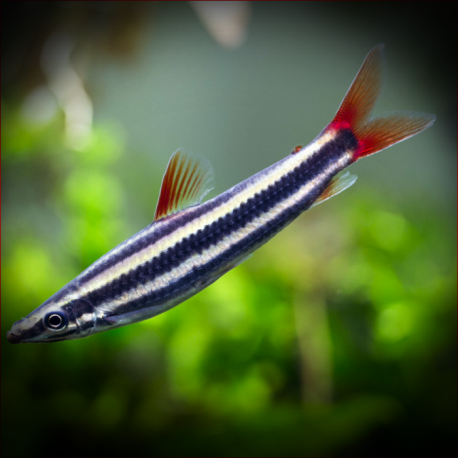More info
Datasheet
| Minimum Tank Size | 160 litres / 42.27 US gallons |
| Maximum Size | 12.5cm / 4.92inches |
| Temperature | 20°C / 68.00°F - 28°C / 82.40°F |
| Hardness | 1.01dgH / 18ppm - 15.02dgH / 268ppm |
| pH | 5.5-7.5 |
General Description
Anostomus ternetzi, commonly known as Ternetz's Anostomus, is a species belonging to the Characiformes order. It is one of the five valid species within the Anostomus genus, with a maximum size reaching 12.5cm. This species is known for its oblique 'head-down' swimming posture, a characteristic that has led to it being colloquially referred to as a 'headstander.'
Aquarium Setup
For Anostomus ternetzi, a minimum tank size of 160 litres is recommended. Setting up the aquarium in a biotope-style, with a sandy substrate, smooth rocks, driftwood roots and branches entering the water, is ideal. Bright lighting encourages algae growth, a dietary staple for the fish, but aquatic vegetation may be consumed. Well-oxygenated water with moderate flow and secure cover are essential due to their jumping abilities.
Behaviour
Although Ternetz's Anostomus is commonly found in large shoals, it can display aggressive behavior towards conspecifics if kept in small numbers. To mitigate this, it is advisable to maintain groups of six or more in larger tanks. When housed with other fish, peaceful medium to large species such as loricariids and cichlids are suitable tankmates.
Feeding and Diet
Ternetz's Anostomus is omnivorous but primarily herbivorous. Their diet should consist of small live and frozen foods, supplemented with vegetable matter like blanched spinach, lettuce, cucumber, courgette, and algae wafers to ensure nutritional balance.
Reproduction & Dimorphism
Information regarding the reproduction of Anostomus ternetzi remains unrecorded, and there is no known sexual dimorphism distinguishing between male and female individuals.
Habitat and Distribution
In the wild, Ternetz's Anostomus can be found in rocky areas along fast-flowing river and stream edges in regions spanning from the Río Orinoco system in Brazil, Colombia, and Venezuela to coastal river basins in Guyana, Suriname, and French Guiana. They primarily graze on algae and small invertebrates as part of their natural habitat.

